DAREDEVIL #35 (1967)
by Stan Lee and Gene Colan
This will lead to Daredevil fighting Doctor Doom pretty soon, but this time the main adversary is another Fantastic Four villain: “don’t call me Paste Pot Pete” Trapster.

I’ll cover “Paste Pot Pete” eventually. I have to.
We begin with Trapster crashing into the office of Daredevil’s civilian identity, blind lawyer Matt Murdock.
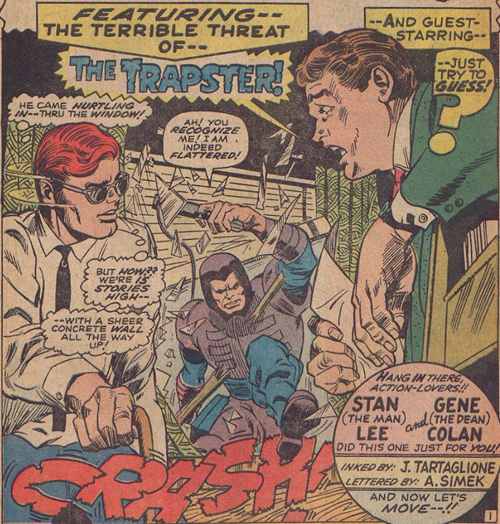
Trapster’s main gimmick is his paste, a super-adhesive that is powerful enough to stop the Thing (at least for a while).
He uses it to incapacitate Matt’s colleague Foggy Nelson and their secretary Karen Page.
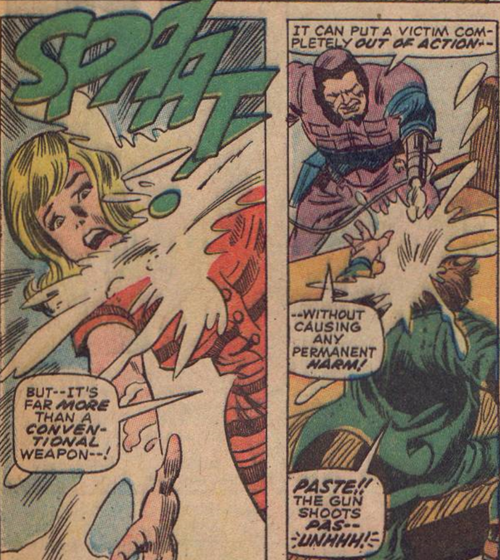
A solid introduction, even if it’s hard to sell “paste” as a threatening weapon. Especially if it forces your victims into awkward positions.

And why is Trapster holding a lawyer hostage? Because he wants to ask a legal question: “can you get sentenced if you kill someone and the body isn’t found?”.
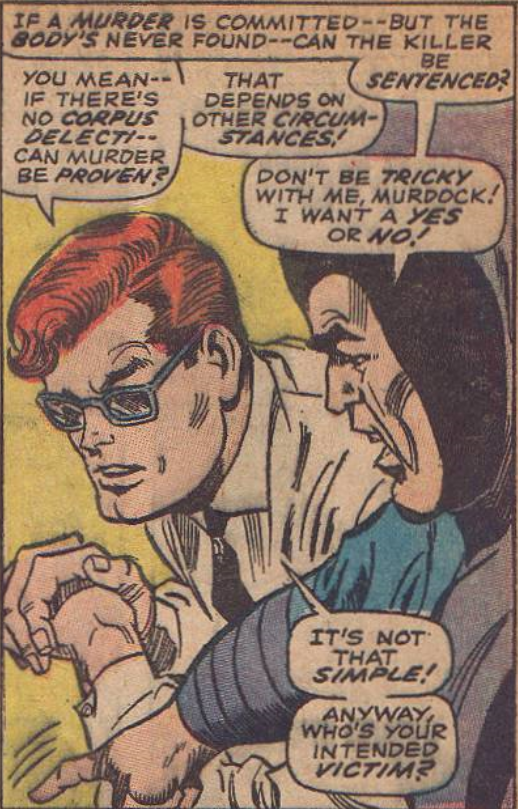
Well it’d be easier to get away from it if you didn’t publicly announce that you’re going to kill someone, Trapster!
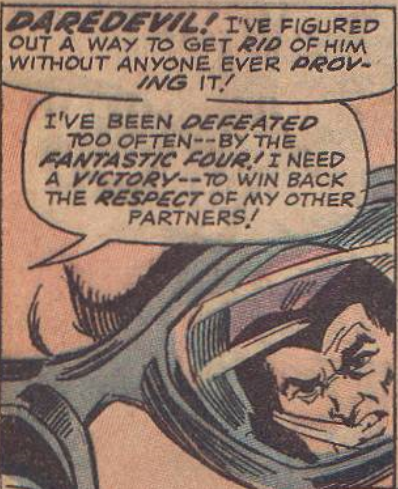
However Trapster isn’t THAT dumb. He’s doing this on purpose because it’s public knowledge that the Nelson&Murdock legal firm is friends with Daredevil, and he wants to draw him out.
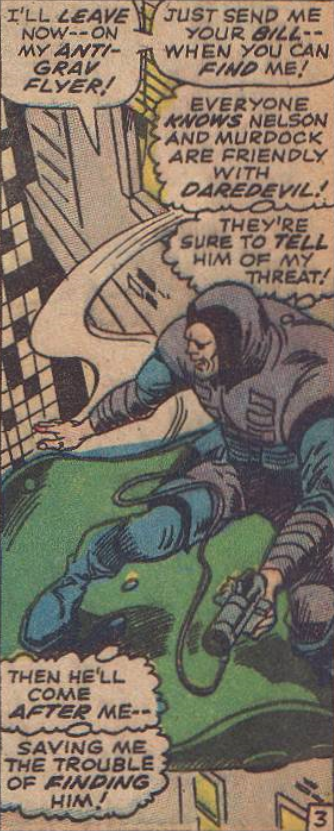
If that’s true, why don’t just kidnap his friends?
By the way, did I mention that Trapster’s paste is usually a problem for the Fantastic Four? Because in this story its weakness is nail polish remover.

I blame this on the “Marvel method”.
If you’re not familiar with it: the artist receives the script, draws the story, and then the writer adds the dialogue later. The artist is Gene Colan, who has never drawn Trapster before.
My theory: the script says “Karen and Foggy free themselves from Trapster’s paste”, so he draws the nail polish remover. Then Stan Lee realizes this isn’t consistent with his Fantastic Four appearances and so adds Foggy’s comment about a “weak paste mixture”.
It’s just a theory but it makes too much sense.
On the other side of the spectrum, that is things that don’t make sense, we have to mention… *sigh*… “Mike Murdock”.

To make a loooong story short: to protect his secret identity, for a time Matt Murdock pretended that he had a twin brother named Mike, and that Mike was Daredevil instead of him.
Yes, that means that in order to protect his secret identity, Matt created ANOTHER secret identity.
No, it doesn’t make more sense in context.
Even Matt acknowledges that “Mike” is more trouble than he’s worth.

This thought about being “a super-swinger” is hilarious, and not for the double entendre (either the modern meaning wasn’t used in the 60s or Stan was having fun), but also because Daredevil has one of the highest number of high profile relationships for a Marvel superhero.
I’ll also mention that Gene Colan is really good at placing a few details here and there to add to the realism of the background, from Karen cleaning the paste out of her hair or Matt stumbling around like he’s really blind.
(well he IS, but with his super-senses it’s a moot point)
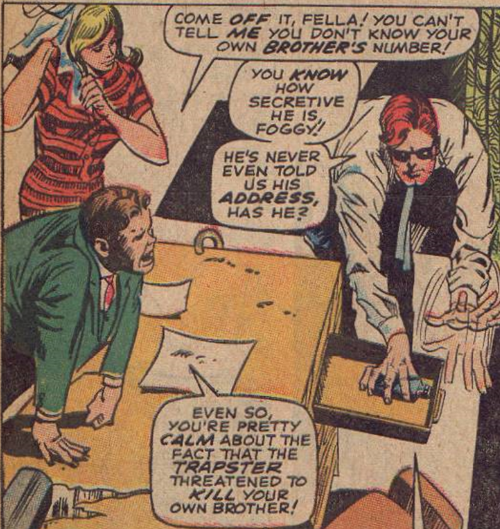
Matt changes into Daredevil and looks for Trapster, finding him immediately since the villain was waiting above the studio with the antigravity device borrowed from fellow villain the Wizard.
Daredevil has the upper hand during most of the fight, but makes the mistake of throwing his billy club (his main weapon).

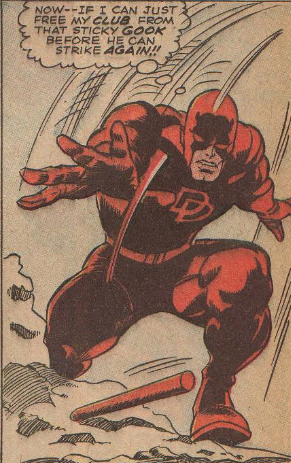
You would think this would mean that he’s disarmed… but no: Daredevil, who I remind you has no super-strength, manages to get his weapon back.
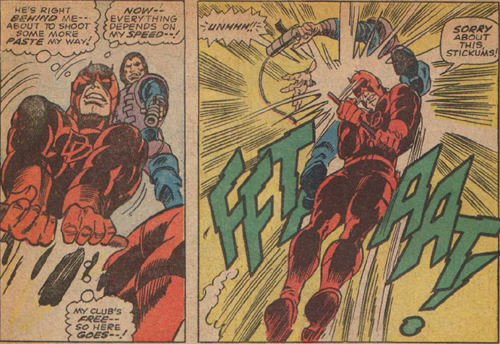
And Trapster would be defeated if it wasn’t for the Wizard’s anti-gravity disks…

…which he uses to send Daredevil flying.
So this is really more a victory for the Wizard than for Trapster, isn’t it?
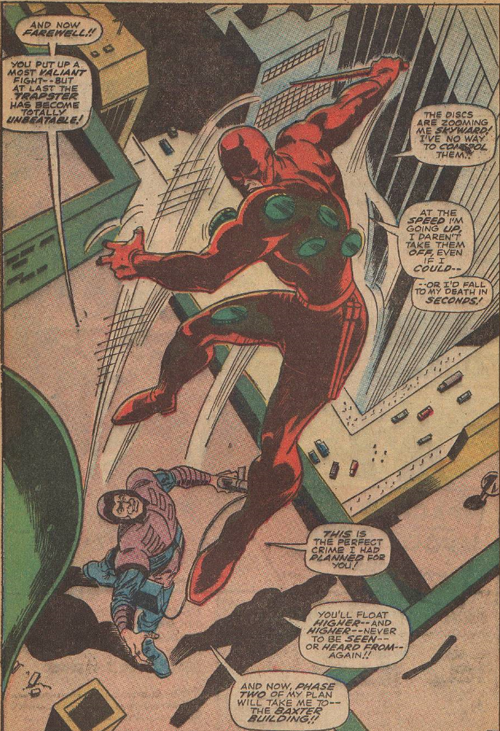
But Trapster thinks it’s still HIS victory, not the Wizard’s.
Which is why he returns to the Wizard’s hideout.

And uses a “plasti-cream” created by Wizard to disguise himself as Daredevil.
But you know, this is totally Trapster’s victory. Not the Wizard’s.
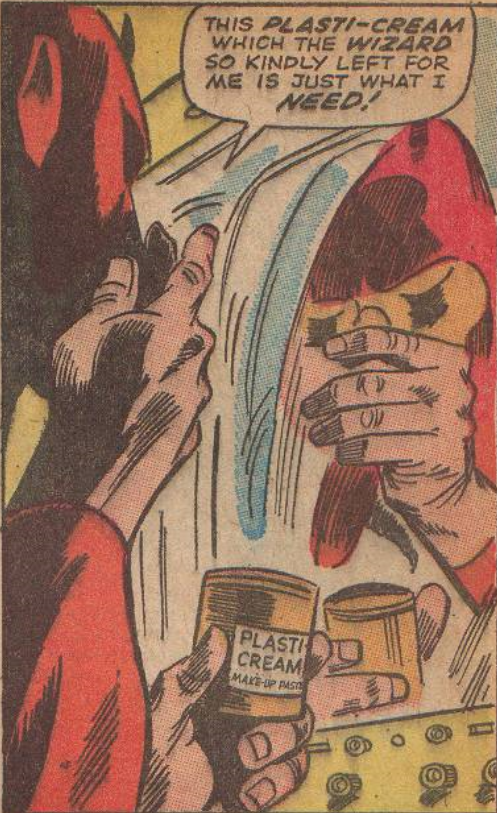
Why go through ALL this trouble, you may ask? Because Trapster wants to sneak into the headquarters of the Fantastic Four.

AND IT WORKS.

He ambushes the Invisible Girl (in the brief period when she’s wearing a skirt over her costume, Saturn Girl style).
And either the shock of seeing Daredevil with a gun gives her a seizure or that’s a WEIRD pose.

With the Invisible Girl glued to the floor, Trapster sets up a bomb that will explode as soon as the rest of the team arrives and then… he just leaves.
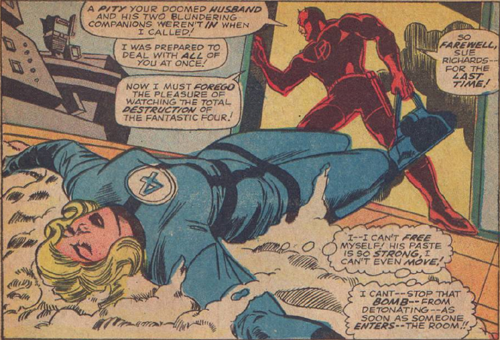
WHAT!?
He doesn’t even knock Susan out! Why isn’t she at least using her force field to prevent him from escaping!? COME ON!!!
Meanwhile, Daredevil escapes from Trapster’s clever trap by… simply taking the antigravity disks off. Note the dialogue trying to save the situation by saying that they were “purposely” attached loosely.
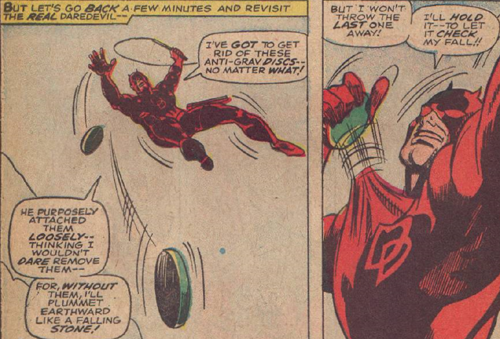
Good thing flagpoles are made of some kind of flexible but incredibly resistant material that can withstand the full weight of a grown man falling from hundreds of feet.

While this is going on, the Invisible Girl is just chilling on the floor, next to a bomb that will explode if anyone walks into the room.

And that’s our cliffhanger!
Historical significance: 0/10
Utterly forgettable for Daredevil and the Fantastic Four. Even Trapster, who is supposed to improve his reputation from this encounter, won’t be affected. The only remotely interesting consequence is that this will eventually lead to the Doctor Doom fight.
Silver Age-ness: 3/10
For the Marvel scale, this is pretty low. If Mike Murdock made an actual appearance if would score a lot higher, but he’s just mentioned and quickly brushed aside (which is the best way to use Mike Murdock if you have to).
Does it stand the test of time? 2/10
The art is the only saving grace… most of the time. Gene Colan is one of the greats, but he’s much more comfortable with swashbuckling adventure than with real supervillains. He gets some mileage with some unusual perspectives, but that’s it.
Story-wise… yeesh. Despite evidence to the contrary Trapster CAN be an interesting and even intimidating enemy on his own (he’s been in some good Spider-Man stories), but here he’s just too generic and too reliant on the Wizard’s technology. You almost have to wonder if the Wizard was originally going to be Daredevil’s adversary for this issue.
And Invisible Girl being so utterly useless is inexcusable for a 1967 story. By this time they knew better!
